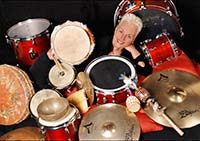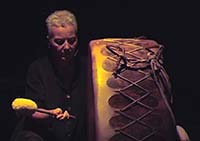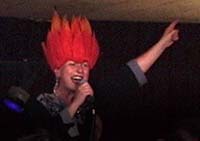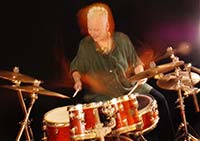 |
|||||
The Drumming GoddessesA new generation of women percussionists celebrates rhythm and the drum, in spirit and musicality Carl McColma , New Age Voice Magazine Fifteen years ago, if the average person on the street were asked to describe New Age music, he or she would probably try to explain the sound of George Winston, Steven Halpern, or Kitaro. Soothing, atmospheric, ambient, relaxing - these would be the words used to try to capture the feel of New Age. An unsympathetic listener might also accuse the music of being boring, monotonous, unmelodic – and lacking a beat. That was then; this is now. The 1990’s saw an incredible diversification of what New Age encompassed as a musical genre. From the arrival of the Celtic-influenced sounds of Enya and Loreena McKennitt, to the Native American music or R. Carlos Nakai and Coyote Oldman, to the chanting of Gregorian or Tibetan monks, New Age took on the multicultural face of world music, bringing a much richer palette of sounds to the genre. And following the work of the men’s movement gurus like Robert Bly and Sam Keen, drumming – regarded not only as a tool for shamanic trancework but also as a symbol for unity among conscious men - became a staple in the New Age diet. But no other category of New Age music carried the gender identity of drumming. The harp, keyboards, and flute could be played by men or women. But the drum was strictly for the guys – Mickey Hart, Babatunde Olatunji, David and Steve Gordon, Brent Lewis, and Glen Velez were some of the early names. Music might be a universal force and the New Age might speak to the spiritual unity of all people – but the beat belonged to the boys. Not anymore. “I had wanted to learn to play the drum set as a teenager but was told that the drums were for boys,” says Layne Redmond, frame drum virtuoso and author of the landmark book When the Drummers Were Women. Layne’s experience was not unique. Percussionist Barbara Borden notes, “So many women have come up to me and said, ‘I’ve wanted to play drums, but…’ and then came the litany: ‘girls don’t play drums; it’s not lady like.’” Yet despite all the misguided parents and teachers who may have discouraged a generation of girls from keeping the beat, Redmond and Borden are but two examples of an emerging groundswell of women who have in recent years produced a distinctive body of work celebrating the pulsating power of women’s drumming. Whether performing as solo artists like Borden, Janelle Burdell, Alessandra Belloni, or Ubaka Hill, or in ensembles like Inanna or Layne Redmond’s Mob of Angels, the New Age has become home to a small but growing community of drumming Goddesses. And that’s not “goddess” in the sense of Marilyn Monroe, but “Goddess” in the sense of Isis, Diana, or Demeter. For the women drummers in the New Age celebrate not only the musicality of the drum, but its spirituality as well. In 1997, the gauntlet of women’s drumming was thrown down by Redmond in her provocative, profusely illustrated, and thoroughly researched book When the Drummers Were Women. It expands on a theme she first explored in her instructional video, A sense of Time – that drumming, far from being the male prerogative our society assumes it to be, originally was the province of women, especially priestesses of many Goddess and mystery religions throughout the ancient world. Redmond backs up her assertion with artistic evidence from around the globe. In the image of the drumming priestess, feminism, music and pagan spirituality converge pounding out a life-giving pulse dedicated to the Sacred Mother, in which women find the freedom to be who they truly are. But more than a historical tour de force, When the Drummers Were Women encouraged women to claim their freedom to tap – literally – into their own ecstasy, the ecstasy of the primal rhythms of the Divine Feminine. Lest anyone assume this connection between drumming and Goddess spirituality is merely Layne Redmond’s idiosyncratic marketing ploy, other women drummers from all over the country echo a powerful sense of the spirit of percussion. This appears in CD titles and covers, from Barbara Borden and Sheilah Glover’s Lady of the Serpent Skirt (featuring an image of the Cretan Snake Goddess on the CD cover) to Ubaka Hill’s Dance the Spiral Dance (a nod to Starhawk’s The Spiral Dance, a bestselling book on Goddess spirituality.) It appears in liner notes – Hill writes, “Special heart-centered gratitude is extended to the Goddess-Spirit in all of her aspects…” while the notes in Inanna’s CD Listen explain, “This all women’s band takes its name from the ancient Sumerian Goddess, Inanna. She was/is the almighty creator/destroyer, and one of the first drummers.” And it appears in the words of the drummers themselves. Barbara Borden prefers to use symbols more universal than the Goddess when talking about percussion, but she clearly sees drumming as a spiritual endeavor. “Heidegger said, ‘A person is not a thing or a process, but an opening through which the Absolute can manifest.’ That’s why drumming is so wonderful – it’s a psychic vacuum. It makes room within, because it turns off the mind; it alters brain waves, getting you from a beta state to an alpha state, and maybe even to a delta state, where you can really let go.” Innana’s Tori Morrill understands the spirit of drumming in terms of healing. “By learning these ancient rhythms and developing new ones, I have become closer to my true self. Drumming brought me to this place of greater clarity. To me, the healing potential of the drum is indisputable. Time and again I have talked with ‘out-of-sorts’ people who were transformed after playing and hearing this music. Being around the vibrations that drumming creates seems to provide healing.” Healing…Goddess spirituality…meditation…ritual. These are the elements that emerge again and again in the words and the music of the diverse community of women drummers. The music of these performers is broad and diverse, ranging from African traditional rhythms to Middle Eastern drones to Mediterranean revels, with a rich variety of modern compositions performed as well. But while musically they plumb a variety of tonal languages, the message seems to be universal in its spiritual application… Although Barbara Borden’s CD’s are not as explicitly mystical, an aura of the sacred still permeates her work – not only her recordings, but her busy performance and teaching schedule as well. Ever since her tenure as the drummer for Alive!, a legendary San Francisco women’s group, Borden has never limited herself to playing only for the sake of entertainment. Whether through the celebratory spirit of women’s music or her more recent work using music to reach out to homeless adults and at-risk youth, Barbara Borden plays both for joy and for healing and spiritual wholeness. That holistic spirit pervades her recordings, from her collaborations with Sheilah Glover to her solo compositions like All Hearts Beating and Beauty in the Beat. Indeed, Beauty in the Beat could be described as an hour-long love letter to the many varieties of percussion available to the world music connoisseur – from the traps to hand drums, wooden blocks to bells and shaker, Borden employs a smorgasbord of rhythmic noisemakers to tease out a rich sonic tapestry of syncopation. As a result of her special magic, drums and percussion combine to create a spiritual “orchestra…” Although these women drummers – Layne Redmond, Barbara Borden, Ubaka Hill, Inanna’s Tori Morril, Italian tambourinist/vocalist Alessandra Belloni and percussionist, teacher and facilitator Janelle Burdell – have yet to score a hit like Mickey Hart’s Planet Drum or David and Steve Gordon’s Sacred Earth Drums, it’s probably just a matter of time until one or more of them do. Their sense of excitement, spirituality, and commitment to music – not just as an entertainment product but as a force for making the world a better place – is deeply refreshing in this age of listening posts in corporate offices and thematically packaged anthologies…
|
|||||
Copyright © 2019, Pulse of Peace Pictures PO Box 1424 Mill Valley, CA 94942
|
|||||




